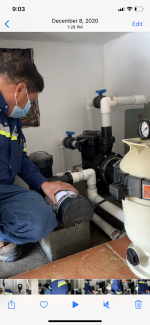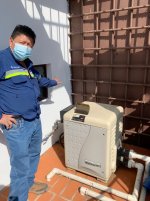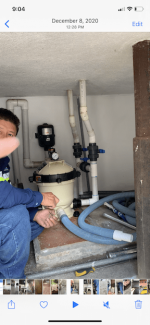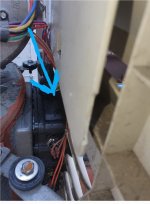Hi There,
Posting the first time.
I have a mastertemp 200 that is installed on a concrete platform that is the roof of a small machine room where the pump, filters, etc are located (also installed on concrete). The heater is for a large 8 person spa, and is located in Antigua, Guatemala (which makes everything like finding parts and service trickier). I'm having a very frustrating and strange problem that I hope someone here can advise me with.
The system was not in use for several months before I took over the property, which is an Airbnb. A maintenance technician came and replaced the in-line filter with an entirely new unit. After just a few uses of the jacuzzi, it developed a very small leak. I called the owner and rather than send someone to fix it, they took the whole unit away. They notified me there was a small crack in the manifold.
They replaced that unit with their own Mastertemp 175 from their house, and lo and behold within just a couple of uses the manifold cracked, a big crack, like 3 inches long and water sprayed out of it like a geyser.
I had a replacement manifold sent down from the USA for the original heater, and that was installed back into the original mastertemp 200. After just a few weeks BANG, again the brand new OEM manifold suddenly cracked and sprayed out like a geyser.
The owners were sending their own technicians and to be honest I don't think they were spa heater specialists, but even still this seems like a very strange problem. The heater seems to be on a stable service and I certainly don't notice any vibrations. That said, when they installed the second, provisional heater I did immediately tell the installers I was hearing a very deep base sound, which stopped when the heater turned off, but they didn't seem to think it was an issue (obviously wrong).
Does anyone know what could be happening? I'm hesitate to install another new manifold without solving the problem because I feel like I'll just be throwing away another quick $400. I don't even want to install a new heater because we've used two different heaters in this situation and BOTH have ended up with the same cracked manifolds.
I called Pentair and all they could tell me was probably some pressure or force on the tubes that was putting pressure on the manifold to twist and coupled with some kind of vibration, maybe that was happening...but that was all they could suggest.
I'm going to have to close my place without the jacuzzi (it's big selling point) and that will mean losing money hand over fist...so I would be really grateful for any input!
Thanks!
Posting the first time.
I have a mastertemp 200 that is installed on a concrete platform that is the roof of a small machine room where the pump, filters, etc are located (also installed on concrete). The heater is for a large 8 person spa, and is located in Antigua, Guatemala (which makes everything like finding parts and service trickier). I'm having a very frustrating and strange problem that I hope someone here can advise me with.
The system was not in use for several months before I took over the property, which is an Airbnb. A maintenance technician came and replaced the in-line filter with an entirely new unit. After just a few uses of the jacuzzi, it developed a very small leak. I called the owner and rather than send someone to fix it, they took the whole unit away. They notified me there was a small crack in the manifold.
They replaced that unit with their own Mastertemp 175 from their house, and lo and behold within just a couple of uses the manifold cracked, a big crack, like 3 inches long and water sprayed out of it like a geyser.
I had a replacement manifold sent down from the USA for the original heater, and that was installed back into the original mastertemp 200. After just a few weeks BANG, again the brand new OEM manifold suddenly cracked and sprayed out like a geyser.
The owners were sending their own technicians and to be honest I don't think they were spa heater specialists, but even still this seems like a very strange problem. The heater seems to be on a stable service and I certainly don't notice any vibrations. That said, when they installed the second, provisional heater I did immediately tell the installers I was hearing a very deep base sound, which stopped when the heater turned off, but they didn't seem to think it was an issue (obviously wrong).
Does anyone know what could be happening? I'm hesitate to install another new manifold without solving the problem because I feel like I'll just be throwing away another quick $400. I don't even want to install a new heater because we've used two different heaters in this situation and BOTH have ended up with the same cracked manifolds.
I called Pentair and all they could tell me was probably some pressure or force on the tubes that was putting pressure on the manifold to twist and coupled with some kind of vibration, maybe that was happening...but that was all they could suggest.
I'm going to have to close my place without the jacuzzi (it's big selling point) and that will mean losing money hand over fist...so I would be really grateful for any input!
Thanks!





